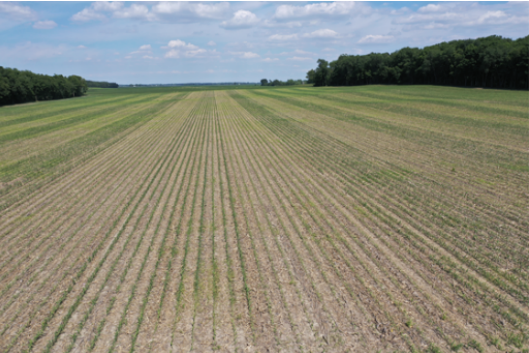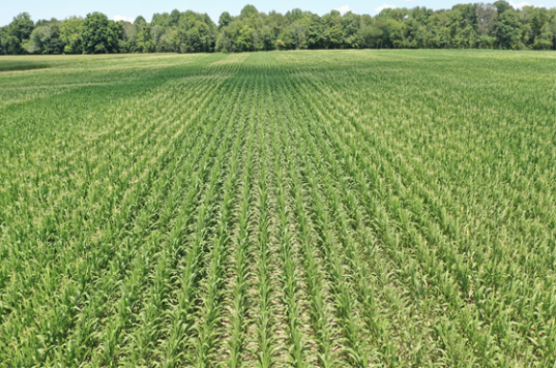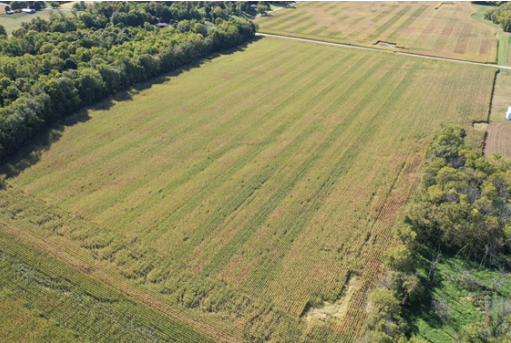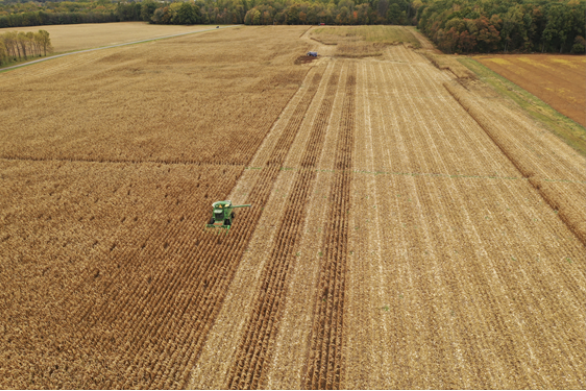This summary is based on 55 field scale research trials conducted at Purdue Ag. Centers and with on-farm collaborators around the state of Indiana from 2014 – 2022. Many of the trials served as research projects for our former graduate students Cody Hornaday, Jason Lee, and Daniela Orjuela-Diaz.
Research Summary
Starter fertilizer in 2x2 placement usually speeds up the plant development rate and dry matter accumulation of corn during vegetative growth stages. In-furrow fertilizer (pop-up) effects on early growth are not as large as higher nitrogen rates applied in 2x2 placement.
Faster crop development results in earlier silking, earlier grain maturity, and drier grain at harvest. Starter fertilizer, depending on placement and rate, reduced grain moisture at harvest between 0.6 and 1.4 percentage points compared to no starter fertilizer in 80% of the trials (43 of 54). Grain moisture was drier with starter, than without starter, by an average of 1 percentage point whether or not a grain yield increase occurred.
Grain yield responses to 2x2 starter fertilizer occurred less frequently in our trials than did grain moisture responses.
In 24 of 55 trials, yield response to 2x2 starter fertilizer (23-50 lbs. N) averaged 7 bushels per acre (bu/ac) compared to no starter fertilizer and ranged as high as 18 bu/ac. No yield response to this range of starter fertilizer was detected in the other 31 trials.
In 4 of 20 trials that compared normal (25-35 lbs. N) to higher than normal (46-50 lbs N) rates of 2x2 starter fertilizer, yields with the higher starter rate averaged 5.2 bu/ac greater than those with the normal rate. No yield differences between the two starter rates were detected in the other 16 trials.
In-furrow (pop-up) starter fertilizer (3-5 lbs. N) outyielded the [No Starter] control in only 1 of 21 trials (6.1 bu/ac) and decreased yield in 2 other trials by 3.3 and 5.4 bu/ac. No yield response to in-furrow fertilizer was detected in the other 18 trials.
A combination of in-furrow plus 2x2 starter fertilizer (total of 25 lbs. N) was evaluated in 19 trials, but only outyielded a standard (25 lbs. N) 2x2 starter fertilizer treatment in one of those trials by 6.8 bu/ac.
In 5 trials that evaluated N, N+P, and N+P+K starter 2x2 fertilizer sources, the nitrogen component of the 2x2 starter fertilizer was found to be the primary component that resulted in starter fertilizer benefits.

Figure 1. Taller plants, more biomass, and more advanced growth stage are common results of starter fertilizer use.
Introduction
Starter fertilizer is the practice of applying a band of fertilizer with or near the seed at the time of planting. The most common applications are in-furrow with the seed (aka pop-up) or 2x2 (a band placed 2 inches below and 2 inches to the side of the seed). Other distances from the seed including on the soil surface are sometimes utilized.
Research in Indiana over the years, including our field trials, suggests that corn response to starter fertilizer is based primarily on the nitrogen component of the fertilizer, although farmers often include phosphorus and sometimes potassium. For soils prone to zinc deficiency, including zinc in starter fertilizers is a convenient and economical method to provide that nutrient to the crop.
Precautions when using starter fertilizer
Application of starter fertilizer at planting is not without risk, especially when placed in-furrow with the seed. Seed germination and seedling establishment can be damaged by too much of certain nutrients. Damage to seed or plant tissues can arise from salt, ammonia, and other components plus breakdown products. Direct contact of fertilizer with the seed is the riskiest placement. Urea, ammonium thiosulfate, and boron should never be placed with the seed.
For other fertilizers containing nitrogen and potassium we recommend no more than 5 pounds of nitrogen (N) plus potassium (as K2O) per acre on sandy soils and no more than 8 lbs. N plus K2O per acre for silt loam and heavier-textured soils. The more soil between the fertilizer and the seed the better, although problems can still occur especially in sandy soils and low soil moisture. We recommend applying no more than 20 lbs. N plus K2O per acre within 1 inch of the seed and no more than 100 lbs. N plus K2O per acre in a standard 2x2 placement. Rates approaching 100 lbs. N plus K2O per acre in a 2x2 placement are not likely agronomically beneficial and often adds additional re-fill time to the planting operation.
Our field scale trials
We began evaluating corn responses to starter fertilizer in field scale trials beginning in 2014. Since then, we have conducted 55 trials around the state at Purdue Ag. Centers and with on-farm collaborators. The nature of the starter fertilizer treatments varied over the years. Nineteen trials evaluated in-furrow (3 gal/ac of 10-34-0 or 5 gal/ac of 6-24-6), traditional 2x2 (28-0-0 or 19-17-0) and in-furrow plus 2x2 placements compared to no starter fertilizer. Twenty trials included 2 rates of 2x2 starter fertilizer (25 and 50 lbs. N per acre). The remainder of the trials focused on comparing single rates of 2x2 starter fertilizer (either 28-0-0 or 19-17-0) ranging from 25 to 40 lbs. N per acre with no starter fertilizer.
Sidedress nitrogen rates were adjusted plot by plot in every trial to ensure that every plot received the same total amount of nitrogen fertilizer for the season. These totals were selected based on previous research we had conducted that established optimum N rates for different areas of Indiana. The corn hybrids used in these replicated field trials varied location to location and year to year, but all were widely grown hybrids well-adapted to Indiana. Seeding rates varied slightly among the trials from about 30,000 to 34,000 seeds per acre, except at the Southwest Purdue Ag. Center where 27,000 seeds per acre was planted because of its drought-prone sandier soils.
All the trials were field scale in size with individual plot widths ranging from 12 – 16 rows wide (30 – 40 ft) by length of field (300 – 2000 ft). Commercial farming equipment was used for every field operation. Plots were harvested with commercial combines equipped with GPS-enabled yield monitors that were calibrated to each field’s conditions the day of harvest. Spatial as-applied planting, fertilizing, and yield data were processed and cleaned using a combination of commercially available mapping and GIS software. The resulting data sets were analyzed using statistical software available to us at Purdue.
Starter fertilizer increases early plant development rate
Starter fertilizer almost always results in faster early development of the crop. This is evident when an applicator nozzle plugs during planting and later that row is noticeably smaller than the other rows. Plants with no starter fertilizer are shorter, have less biomass, and are often lighter green than those receiving the intended rate of starter. This apparent enhanced early growth due to starter fertilizer is mostly because the plants are literally at an advanced growth stage compared to plants grown without starter fertilizer.

Figure 2. No tassels without starter in the center of photo compared to tasseled plants on left and right with starter.
Earlier silking and drier grain at harvest
The consequence of faster leaf development is that pollination occurs earlier, which translates to earlier grain maturity. The earlier maturation allows the grain to dry down during a relatively warmer and longer time period and so grain moisture is less at harvest. Starter fertilizer in general reduced grain moisture at harvest by 0.6 to 1.4 percentage points in 80% of our trials. Drier grain at harvest with starter fertilizer, generally occurs even when grain yield does not respond to starter fertilizer. In 21 of 28 trials where yield was NOT affected by starter fertilizer, grain moisture was still lower than the [No Starter] Control by an average of 1 percentage point. In continuous corn a 2x2 starter rate of 25 lbs. N/ac averaged 1.1 points drier grain at harvest than no starter fertilizer, while twice this N rate lowered moisture 1.4 points on average. When 3 gallons per acre of 10-34-0 was used as pop-up, grain moisture averaged 0.6 point drier compared to no starter. In corn following soybean, grain moisture from a 2x2 starter rate of 25 lbs. N/ac was about 0.8 point lower than no starter. We did not examine higher rates of nitrogen or pop-up in rotation corn.
Yield response to starter fertilizer
In continuous corn, starter fertilizer at 20 – 50 lbs. N/ac increased yield in 15 of 36 trials compared to no starter fertilizer. The yield increases due to starter fertilizer at the responsive locations ranged from 2.4 to 18.4 bu/ac and averaged 8.3 bu/ac. Most of the responses we saw were at 3 locations that were farmed no-till.
Fifty pounds of nitrogen per acre as 2x2 starter was compared with 25 lbs. N/ac in 19 trials in long-term continuous corn to determine whether the higher starter fertilizer rate would be more beneficial in that cropping system. Yield responded to starter fertilizer in only 7 of the 19 trials and of those, yield increases were greater for the high starter rate in 4 trials by an average of 5.2 bu/ac.
Pop-up fertilizer (3 gal 10-34-0/ac or 5 gal 6-24-6/ac) increased grain yield in only 1 of 20 trials. At that site the yield increase was 6 bu/ac. However, pop-up fertilizer decreased yield at 2 of 20 trials by 3.3 and 5.4 bu/ac, respectively.
A combination of in-furrow plus 2x2 starter fertilizer (total of 25 lbs. N) was evaluated in 19 trials, but only outyielded a standard (25 lbs. N) 2x2 starter fertilizer treatment in one of those trials by 6.8 bu/ac.
Of 18 trials with rotation corn, starter fertilizer rates ranging from 20 to 45 lbs. N/ac increased yield in 8 trials by an average of 6.5 bu/ac and ranged from 2.7 to 11.7 bu/ac. Responses occurred in 3 of 5 no-till fields, 2 of 5 strip till fields, and 3 of 8 chisel-plowed fields.

Figure 3. Faster development and earlier senescence with starter fertilizer results in drier grain or earlier harvest even when no yield increase occurs.
Costs of starter fertilizer use
In our trials, the extra cost of fertilizer applied as starter was minimal. If P is included in the starter, the difference between the cost of P from granular fertilizer (usually MAP – monoammonium phosphate or DAP – diammonium phosphate) and the cost of P in 10-34-0 is only a few dollars per acre with common fertilizer costs. If only N is included in the starter fertilizer, which was the nutrient most responsible for the responses in our field trials, there is no additional cost to the starter fertilizer because the rate of sidedressed liquid N can be reduced by the amount of N applied at planting. Therefore, considering planting and sidedressing, the same amount of liquid N was used to apply the same amount of total N. If anhydrous is the primary N source than the N provided by liquid N would cost a few dollars per acre more than the N provided by anhydrous ammonia. Naturally, if one uses a higher priced specialty starter fertilizer blend, the cost per acre for starter fertilizer may be more substantial.
If one already has a 2x2 starter system on the planter the occasional increases in yield and the consistent reduction in harvest moisture or earlier harvest come with no additional cost, other than the time it might take to re-fill the fertilizer tank during planting. If buying a new planter, the cost of starter fertilizer attachments should be compared to the potential benefits of greater yield and reduced drying costs or earlier harvest to determine the profitability of purchasing the system. Even if only the benefits of lower grain moisture at harvest are considered, an average point drier grain for, say, a 225 bu/ac grain yield, at 2 cents drying cost per point per bushel, would translate to $4.50/ac savings in grain drying expense. Over 1,000 acres of corn, that would equal $4500 in cost savings per year.
Pop-up starter did not decrease grain moisture as much as 2x2 starter did and provided essentially no yield benefit. Our research suggests little incentive to utilize pop-up (at least with 3 gal/ac of 10-34-0). Higher rates of 10-34-0 or fertilizers of different composition would need to be tested to determine their effectiveness, but at this point we do not believe pop-up starter fertilizer provides significant yield or grain moisture benefits.

Figure 4. Harvest of field-scale fertilizer trial at SEPAC in 2019.
Take-aways from our research
Starter 2x2 fertilizer in corn does not consistently increase grain yield but frequently reduces grain moisture at harvest by as much as 1.5 percentage points. Across our 55 field scale trials, there were no clear relationships between the likelihood of yield response to starter fertilizer and factors like previous crop, soil type, soil drainage, tillage system, planting date, or region of the state. However, while yield increases due to starter 2x2 fertilizer occurred less than half of the time in our trials, the potential for increased yield due to starter 2x2 fertilizer as high as 10 – 15 bu/ac makes its use attractive to consider. If you already have starter 2x2 fertilizer attachments on your planter and if you focus on traditional starter fertilizer sources (e.g., 28-0-0, 10-34-0), we believe that the use of starter 2x2 fertilizer, at 25 to 40 lbs N/ac, is a low-cost form of “crop insurance” against unpredictable soil and weather conditions at and after planting during the important stand establishment period. As indicated earlier, the higher frequency of drier grain at harvest due to starter fertilizer, and the annual cost savings that represents, adds to the attractiveness of making starter 2x2 fertilizer part of your corn production strategies.





